Firstly, sorry for the massive answer size. However, I felt it necessary to include my entire test Activity so that you can see what I have done.
The issue
The issue that you have, is that the DividerItemDecoration has no idea of the state of your row. It does not know whether the item is being deleted.
For this reason, I made a POJO that we can use to contain an integer (that we use as both an itemId and a visual representation and a boolean indicating that this row is being deleted or not.
When you decide to delete entries (in this example adapter.notifyItemRangeRemoved(3, 8);), you must also set the associated Pojo to being deleted (in this example pojo.beingDeleted = true;).
The position of the divider when beingDeleted, is reset to the colour of the parent view. In order to cover up the divider.
I am not very fond of using the dataset itself to manage the state of its parent list. There is perhaps a better way.
The result visualized

The Activity:
public class MainActivity extends AppCompatActivity {
private static final int VERTICAL_ITEM_SPACE = 8;
private List<Pojo> mDataset = new ArrayList<Pojo>();
@Override
protected void onCreate(Bundle savedInstanceState) {
super.onCreate(savedInstanceState);
setContentView(R.layout.activity_main);
for(int i = 0; i < 30; i++) {
mDataset.add(new Pojo(i));
}
final RecyclerView recyclerView = (RecyclerView) findViewById(R.id.recyclerView);
LinearLayoutManager layoutManager = new LinearLayoutManager(this);
recyclerView.setLayoutManager(layoutManager);
recyclerView.addItemDecoration(new VerticalSpaceItemDecoration(VERTICAL_ITEM_SPACE));
recyclerView.addItemDecoration(new DividerItemDecoration(this));
RecyclerView.ItemAnimator ia = recyclerView.getItemAnimator();
ia.setRemoveDuration(4000);
final Adapter adapter = new Adapter(mDataset);
recyclerView.setAdapter(adapter);
(new Handler(Looper.getMainLooper())).postDelayed(new Runnable() {
@Override
public void run() {
int index = 0;
Iterator<Pojo> it = mDataset.iterator();
while(it.hasNext()) {
Pojo pojo = it.next();
if(index >= 3 && index <= 10) {
pojo.beingDeleted = true;
it.remove();
}
index++;
}
adapter.notifyItemRangeRemoved(3, 8);
}
}, 2000);
}
public class Adapter extends RecyclerView.Adapter<Holder> {
private List<Pojo> mDataset;
public Adapter(@NonNull final List<Pojo> dataset) {
setHasStableIds(true);
mDataset = dataset;
}
@Override
public Holder onCreateViewHolder(ViewGroup parent, int viewType) {
View view = LayoutInflater.from(parent.getContext()).inflate(R.layout.adapter_cell, parent, false);
return new Holder(view);
}
@Override
public void onBindViewHolder(final Holder holder, final int position) {
final Pojo data = mDataset.get(position);
holder.itemView.setTag(data);
holder.textView.setText("Test "+data.dataItem);
}
@Override
public long getItemId(int position) {
return mDataset.get(position).dataItem;
}
@Override
public int getItemCount() {
return mDataset.size();
}
}
public class Holder extends RecyclerView.ViewHolder {
public TextView textView;
public Holder(View itemView) {
super(itemView);
textView = (TextView) itemView.findViewById(R.id.text);
}
}
public class Pojo {
public int dataItem;
public boolean beingDeleted = false;
public Pojo(int dataItem) {
this.dataItem = dataItem;
}
}
public class DividerItemDecoration extends RecyclerView.ItemDecoration {
private final int[] ATTRS = new int[]{android.R.attr.listDivider};
private Paint mOverwritePaint;
private Drawable mDivider;
/**
* Default divider will be used
*/
public DividerItemDecoration(Context context) {
final TypedArray styledAttributes = context.obtainStyledAttributes(ATTRS);
mDivider = styledAttributes.getDrawable(0);
styledAttributes.recycle();
initializePaint();
}
/**
* Custom divider will be used
*/
public DividerItemDecoration(Context context, int resId) {
mDivider = ContextCompat.getDrawable(context, resId);
initializePaint();
}
private void initializePaint() {
mOverwritePaint = new Paint();
mOverwritePaint.setColor(ContextCompat.getColor(MainActivity.this, android.R.color.background_light));
}
@Override
public void onDraw(Canvas c, RecyclerView parent, RecyclerView.State state) {
int left = parent.getPaddingLeft();
int right = parent.getWidth() - parent.getPaddingRight();
int childCount = parent.getChildCount();
for (int i = 0; i < childCount; i++) {
View child = parent.getChildAt(i);
RecyclerView.LayoutParams params = (RecyclerView.LayoutParams) child.getLayoutParams();
int top = child.getBottom() + params.bottomMargin;
int bottom = top + mDivider.getIntrinsicHeight();
Pojo item = (Pojo) child.getTag();
if(item.beingDeleted) {
c.drawRect(left, top, right, bottom, mOverwritePaint);
} else {
mDivider.setBounds(left, top, right, bottom);
mDivider.draw(c);
}
}
}
}
public class VerticalSpaceItemDecoration extends RecyclerView.ItemDecoration {
private final int mVerticalSpaceHeight;
public VerticalSpaceItemDecoration(int mVerticalSpaceHeight) {
this.mVerticalSpaceHeight = mVerticalSpaceHeight;
}
@Override
public void getItemOffsets(Rect outRect, View view, RecyclerView parent,
RecyclerView.State state) {
outRect.bottom = mVerticalSpaceHeight;
}
}
}
The Activity Layout
<?xml version="1.0" encoding="utf-8"?>
<RelativeLayout
xmlns:android="http://schemas.android.com/apk/res/android"
xmlns:tools="http://schemas.android.com/tools"
android:layout_width="match_parent"
android:layout_height="match_parent"
android:paddingLeft="@dimen/activity_horizontal_margin"
android:paddingRight="@dimen/activity_horizontal_margin"
android:paddingTop="@dimen/activity_vertical_margin"
android:paddingBottom="@dimen/activity_vertical_margin"
android:background="@android:color/background_light"
tools:context="test.dae.myapplication.MainActivity">
<android.support.v7.widget.RecyclerView
android:id="@+id/recyclerView"
android:layout_width="match_parent"
android:layout_height="match_parent" />
</RelativeLayout>
The RecyclerView "row" Layout
<?xml version="1.0" encoding="utf-8"?>
<TextView xmlns:android="http://schemas.android.com/apk/res/android"
android:layout_width="match_parent"
android:layout_height="wrap_content"
android:id="@+id/text"
android:padding="8dp">
</TextView>

